Common/English Name: Cider Gum Tree
Botanical/Latin name: Eucalyptus gunnii
Height: Up to 35 metres
Longevity: Up to 250 years
Type: Evergreen
Flowers: White flowers throughout the year
Fruits/seed: Small, woody, cup-shaped seed pods
Conditions: Any well-drained soil in full sun
Key facts: A native of Australia, oil from its silvery leaves is added to cough and cold medicines, dental products and antiseptics etc. The didgeridoo, an Aboriginal musical instrument, is made from its wood.
Number 5: Sweet Chestnut
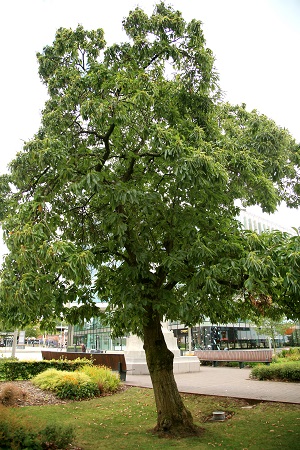
No. 5
Common/English Name: Sweet Chestnut
Botanical/Latin name: Castanea sativa
Height: Up to 35 metres
Longevity: 700+ years
Type: Deciduous
Flowers: Long yellow catkins in June and July
Fruits/seed: Spiky, rounded green seed cases containing chestnut brown, edible fruits
Conditions: Any well-drained soil in partial shade or sun
Key facts: A native tree in southern Europe, western Asia and North Africa it was introduced to the UK many hundreds of years ago. Sweet chestnuts are edible to humans and can be roasted and used in savoury stuffing and desserts.
Number 6: Field Maple
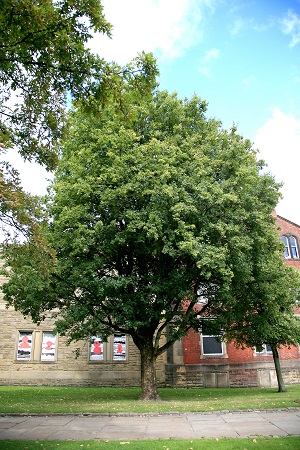
No. 6
Common/English Name: Field Maple
Botanical/Latin name: Acer campestre
Height: Up to 20 metres
Longevity: Up to 350 years
Type: Deciduous
Flowers: Clusters of yellow/green flowers in May
Fruits/seed: Winged, pink-tinged seed pods hang in bunches
Conditions: Any well-drained soil in sun or partial shade.
Key facts: The only maple native to the UK, it is a popular tree in town, cities and hedgerows for its bright yellow autumn colour. It was traditionally used for wood turning and carving for furniture and veneers.
If coppiced it can live 600 years.
Number 7: Common Sycamore
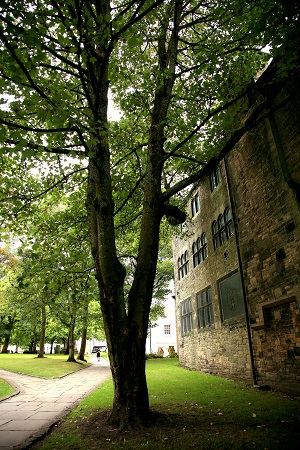
No. 7
Common/English Name: Common Sycamore
Botanical/Latin name: Acer pseudoplatanus
Height: Up to 35 metres
Longevity: Up to 400 years
Type: Deciduous
Flowers: Small, green/yellow flowers hand in spikes or racemes in April/June
Fruits/seed: Brown winged seed pods hang in clusters
Conditions: Any soil, resistant to wind and pollution
Key facts : A native tree in Europe it was introduced to the UK by the Romans (or the Tudors). It grows widely across the UK and supports a range of wildlife species. The timber is used to make furniture and
kitchen ware (chopping boards and spoons) as it does not taint food.
Number 8: Tulip Tree
No. 8Common/English Name: Tulip Tree
Botanical/Latin name: Liriodendron tulipera
Height: Up to 45 metres
Longevity: Up to 300 years
Type: Deciduous
Flowers: Large, tulip-like flowers with pale green/yellow petals in June.
Fruits/seed: Conical fruits that open to disperse seeds on the wind.
Conditions: Deep well-drained soil in the sun
Key facts: A native of North America this hardwood tree is used to make musical organs and interior house panels. Honey made from the pollen of its flowers has a strong flavour and is used by professional bakers.
Number 9: Walnut Tree
No. 9
Common/English Name: Walnut Tree
Botanical/Latin name: Juglans regia
Height: Up to 35 metres
Longevity: Up to 200 years
Type: Deciduous
Flowers: Yellow/green catkins in April and May
Fruits/seed: Fleshy, rounded green fruits containing walnuts.
Conditions: Moist, well-drained soil in sun.
Key facts: A native of S.E. Europe and Asia the tree was brought to the UK by the Romans. The Latin name 'Juglans' comes from the god Jupiter/Jove who was thought to dine on walnuts when he was on Earth.
Further information: Walnut Tree Woodland Trust
Number 10: Cut leaved Alder or Grey Alder Lacinta
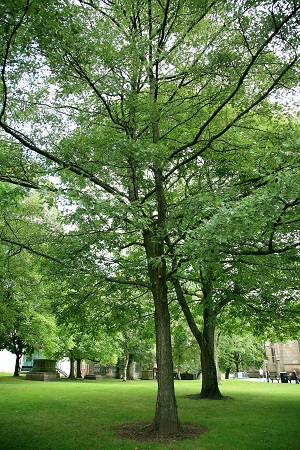
No. 10
Common/English Name: Cut leaved Alder or Grey Alder Lacinata
Botanical/Latin name: Alnus incana ‘Laciniata'
Height: Up to 10 metres
Longevity: 50 – 70 years
Type: Deciduous
Flowers: Purple catkin in February and March
Fruits/seed: Small, brown woody cones (called strobiles) in summer
Conditions: Tolerates wet soils, wind and air pollution. Prefers some shade.
Key facts: The common Alder (Alnus glutinosa) is a native UK tree and was used to make clogs in Northern England. However, this hybrid of the Grey Alder with ornamental deeply lobbed leaves was introduced to the UK from 1861. It can fix its own nitrogen through a symbiotic relationship with the bacterium Frankia alni, which helps the tree to grow in nutrient-poor soils.
Number 11: Red Oak
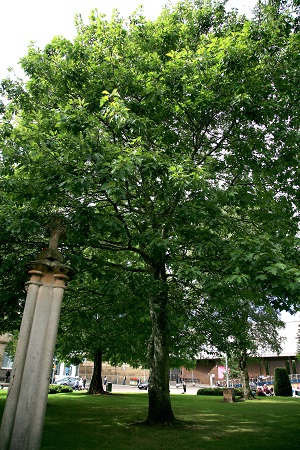
No. 11
Common/English Name: Red Oak
Botanical/Latin name: Quercus rubra
Height: Up to 35 metres
Longevity: Up to 300 years
Type: Deciduous
Flowers: Gold yellow catkins in spring
Fruits/seed; Clusters of acorns with woody cups that hold hard seed cases
Conditions: Slightly acid, well-drained soil in sun
Key facts: A native tree of North American but planted in the UK for its scarlet autumn leaves. It has a symbiotic relationship with sac fungi (ascomycetes) that grow in the soil around its roots and help the tree to take up nutrients and water from the soil while the tree shares its carbohydrates with the fungi.
Number 12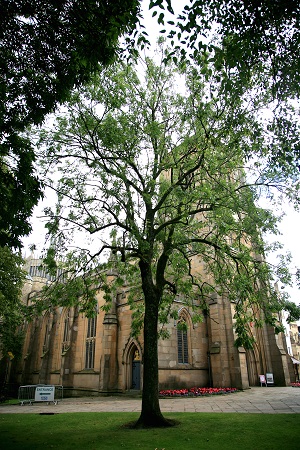 No. 12
No. 12 Common/English Name: Common Ash
Botanical/Latin name: Fraxinus excelsior
Height: Up to 35 metres
Longevity: Up to 400 years
Type: Deciduous
Flowers: Small clusters of green flowers with a purple tinge appear before the leaves in spring.
Fruits/seed: Clusters of winged seeds pods
Conditions: Any well-drained soil in sun
Key facts : A native tree in the UK, Europe, Asia Minor and Africa, producing a widely used hardwood timber. It is the third most common tree in Britain but is currently under threat from ‘Ash dieback disease’; a fungal infection spread on the wind.
Number 13: English Oak
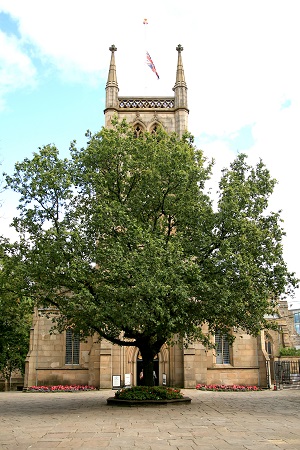
No. 13
Common/English Name: English Oak
Botanical/Latin name: Quercus robur
Height: Up to 30 metres
Longevity: Up to 1,000 years
Type: Deciduous
Flowers: Long, yellow catkins in spring.
Fruits/seed: Clusters of acorns with woody cups that hold hard seed cases.
Conditions: Moist, well drained soil in sun or partial shade
Key facts: A native tree in the UK its hardwood timber is widely used in boat building, house construction and furniture. It is a national symbol and supports 2,300 different wildlife species including mosses, lichen, insects and birds.
Number 14: Sweet Gum Tree
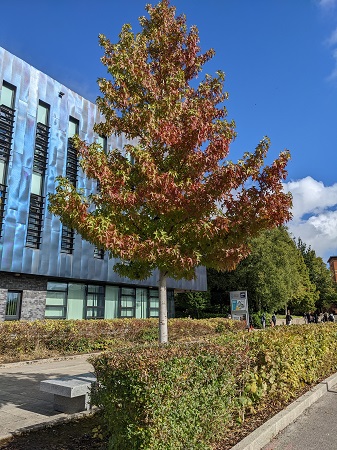
No. 14
Common/English Name: Sweet Gum Tree
Botanical/Latin name: Liquidambar styraciflua
Height: Up to 20 metres
Longevity: Up to 400 years
Type: Deciduous
Flowers: Small globes of green flowers in spring
Fruits/seed: Small, spherical, spikey seed pods
Conditions: Moist but well drained soil in partial shade or sun.
Key facts: Watch out for the leaves turning orange, red and purple in the autumn. This is a native tree of Eastern North America where it is used to make furniture. The resin from the trunk was used by Native Americans for making soaps, glues and medicines.
Further information: Sweet Gum Treet Yale Nature Walks
Number 15: Large-leaved Lime
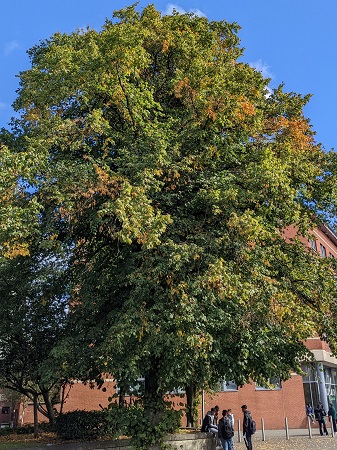
No. 15
Common/English Name: Large-leaved Lime
Botanical/Latin name: Tilia platyphyllos
Height: Up to 40 metres
Longevity: Up to 400 years
Type: Deciduous
Flowers: Scented flowers in summer
Fruits/seed: Small rounded fruits
Conditions: Good soil in sun
Key facts: Linden Tea can be made from the flowers and promotes relaxation and soothes the digestive tract.
Number 16: Dawn Redwood
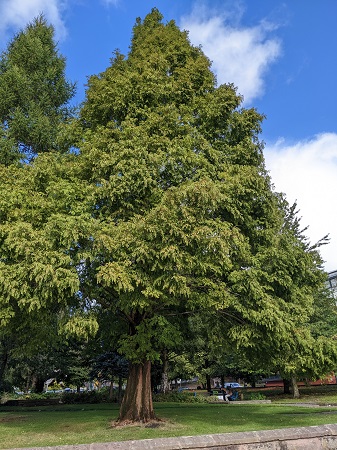
No. 16Common/English Name: Dawn Redwood
Botanical/Latin name: Metasequoia glyptostroboides
Height: Up to 25 metres
Longevity: Up to 400 years
Type: Deciduous
Flowers: Cones
Fruits/seed: Spores develop in small cones
Conditions: Any soil in sun
Key facts: Watch out for the needles turning orange in the autumn. This is a native tree of China, and its timber is traditionally used in building. Trees from the Redwood family grew at the time of the dinosaurs.
Number 17: Maidenhair Tree
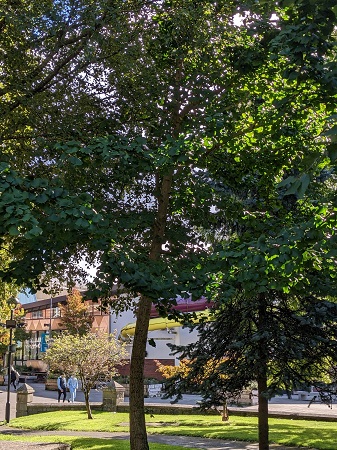 No. 17
No. 17
Common/English Name: Maidenhair Tree
Botanical/Latin name: Ginkgo biloba
Height: Up to 25 metres
Longevity: Up to 1,000 years
Type: Deciduous
Flowers: Catkins-like cones
Fruits/seed: round, yellow fruits
Conditions: Any well-drained soil in sun
Key facts: Look out for the leaves turning butter-yellow in the autumn. The leaves are used medicinally to treat memory loss and poor circulation. Ginkgo are an ancient tree species that have grown on our planet for almost 200 million years.
Number 18: Silver Birch
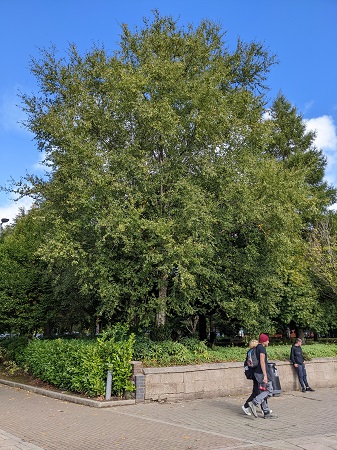 No. 18
No. 18Common/English Name: Silver Birch
Botanical/Latin name: Betula pendula
Height: Up to 30 metres
Longevity: Around 70 years
Type: Deciduous
Flowers: Catkins in April and May
Fruits/seed: Female catkins bear seed when pollinated
Conditions: Tolerates poor soils in sun or light shade
Key facts: This is native to the UK as is known as a ‘pioneer’ tree as it grows well in poor soils and prepares the ground for larger, more long-lived species of tree. Its silver bark provides interest through the winter and its hard timber was used to make bobbins, spools and reels for the cotton industry in Lancashire.
Number 19: Irish Yew
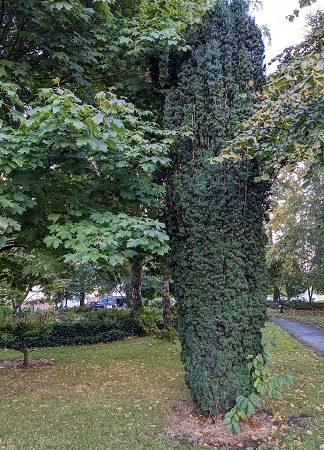
No. 19
Common/English Name: Irish Yew
Botanical/Latin name: Taxus baccata 'Fastigiata'
Height: Up to 7 metres
Longevity: At least 263 years
Type: Evergreen
Flowers: Small flowers with no petals that are wind pollinated
Fruits/seed: Small red fruits in the autumn with toxic flesh
Condition: Prefers well drained soils in sun or light shade and is resistant to urban pollution
Key facts: This is a naturally occurring mutant of the common Yew, which was first discovered in County Fermanagh in Ireland in 1700s. The needles grow in clusters around the twigs, unlike the common Yew whose needles are held in rows. This is a much smaller type of Yew and all existing trees have been grown from stem cuttings taken from the original tree in Ireland. The foliage is toxic and can be fatal if eaten by animals.
Further information: Irish Yew
back to top

